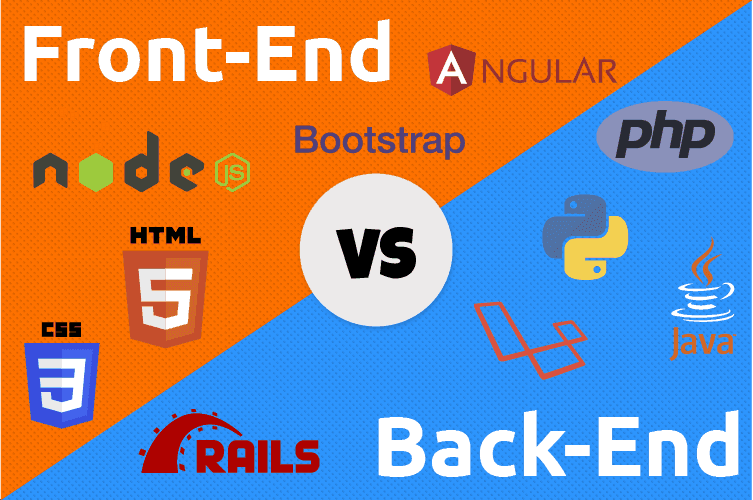In the world of web development, one of the first decisions aspiring developers face is whether to specialize in frontend or backend development. Both roles are critical to building modern applications, but they involve different tools, skill sets, and mindsets.
This guide will help you understand the core differences between frontend and backend development, the skills and technologies each requires, and how to decide which path suits you best.
🧭 What’s the Difference?
At a high level:
- Frontend development focuses on the parts of a website or application that users interact with directly—the “client side.”
- Backend development handles the behind-the-scenes logic, databases, and server-side operations—the “server side.”
Let’s break that down further.
| Aspect | Frontend | Backend |
|---|---|---|
| What it controls | UI/UX, design, browser interactions | Data handling, server logic, API management |
| Users see it? | Yes | No |
| Key focus | Responsiveness, interactivity, accessibility | Efficiency, security, scalability |
🎨 Frontend Development: The User Experience Engine
What It Is:
Frontend developers create everything users see and interact with—buttons, layouts, animations, and content structure.
Core Technologies:
- HTML: The structure of web content.
- CSS: Styling, layout, and visual design.
- JavaScript: Interactivity and behavior.
Popular Frameworks & Libraries:
- React (by Meta)
- Vue.js
- Angular
- Svelte
- Tailwind CSS (utility-first CSS)
- Next.js, Nuxt.js (for full-stack or SSR apps)
Required Skills:
- Understanding of responsive design and mobile-first development.
- Familiarity with browser dev tools and debugging.
- Accessibility (a11y) best practices.
- Knowledge of frontend build tools (Vite, Webpack).
- Basic SEO principles for content visibility.
Tools of the Trade:
- Code editor: VS Code
- Design handoff tools: Figma, Zeplin
- Version control: Git
- Browser dev tools: Chrome, Firefox
Career Path:
Frontend developers often evolve into:
- UI/UX engineers
- Mobile app developers (via React Native or Flutter)
- Full-stack developers
- Design-focused roles like product engineer or creative technologist
🔧 Backend Development: The Power Behind the Scenes
What It Is:
Backend developers build the logic, infrastructure, and data systems that power the frontend. They’re responsible for authentication, APIs, databases, server configuration, and more.
Core Technologies:
- Programming Languages: JavaScript (Node.js), Python, Java, Ruby, Go, PHP
- Databases: PostgreSQL, MySQL, MongoDB, Redis
- APIs: REST, GraphQL
- Servers: Express.js, Django, Flask, Spring Boot
Required Skills:
- Understanding of databases and data modeling.
- Experience with API design and documentation.
- Knowledge of server-side rendering and templating.
- Authentication and authorization protocols (OAuth, JWT).
- Security practices (XSS, CSRF protection).
Tools of the Trade:
- Postman or Insomnia (for testing APIs)
- Docker (for containerization)
- CI/CD tools (GitHub Actions, Jenkins)
- Cloud platforms (AWS, Azure, Google Cloud)
Career Path:
Backend developers often grow into:
- DevOps or infrastructure engineers
- Database administrators
- Site reliability engineers (SREs)
- Full-stack developers
- Cloud engineers
🧑💻 Full-Stack Development: The Hybrid Path
If you’re excited about both domains, becoming a full-stack developer might be right for you. Full-stack devs are proficient in both frontend and backend, allowing them to build complete applications from start to finish.
Full-Stack Tools:
- JavaScript-based stacks like MERN (MongoDB, Express, React, Node.js)
- Jamstack: Headless CMS + frontend framework + CDN
- Serverless frameworks: Vercel, Netlify, AWS Lambda
Pros:
- Greater flexibility in projects.
- More career opportunities.
- Better understanding of product as a whole.
📈 Market Demand & Salaries
Both frontend and backend developers are in high demand. However, demand can shift depending on industry and location.
Salary Comparison (U.S. Averages as of 2025):
| Role | Entry Level | Mid-Level | Senior |
|---|---|---|---|
| Frontend Dev | $70k–$90k | $90k–$120k | $120k–$160k+ |
| Backend Dev | $80k–$100k | $100k–$130k | $130k–$170k+ |
| Full-Stack Dev | $85k–$110k | $110k–$140k | $140k–$180k+ |
Note: Salaries vary widely based on region, industry, and experience.
🧠 How to Choose What’s Right for You
Ask yourself the following:
1. Do You Enjoy Design or Logic More?
- If you’re drawn to design, layout, animations, and how users interact with websites, frontend may be a better fit.
- If you prefer problem-solving, data, infrastructure, or system design, backend might suit you better.
2. Do You Prefer Instant Feedback or Working Behind the Scenes?
- Frontend development often gives immediate visual feedback (you click a button, it animates).
- Backend tasks may involve more abstract problem-solving (e.g., building an authentication system).
3. What’s Your Learning Style?
- Frontend tends to be more visually stimulating and faster to prototype.
- Backend requires a deeper understanding of architecture and systems but has more defined logic flows.
4. What Kind of Projects Do You Want to Build?
- Frontend focus: Landing pages, UI/UX prototypes, SPAs, e-commerce interfaces.
- Backend focus: APIs, payment processing, data analytics engines, authentication services.
🔄 You Can Always Switch or Blend
The good news? Your decision doesn’t lock you in forever. Many developers start in one area and transition over time—or become full-stack. Frontend and backend skills increasingly overlap, especially with the rise of serverless, Jamstack, and headless CMS solutions.
Learning a bit of both can also make you more empathetic when working with cross-functional teams, improving communication and collaboration.
Conclusion
There’s no universally “better” choice between frontend and backend—just the one that fits your interests, learning style, and long-term goals.
✅ If you love visuals, user experience, and immediate feedback, go frontend.
✅ If you enjoy building logic, handling data, and solving complex system problems, go backend.
✅ If you want to do it all and work on end-to-end features, go full-stack.
Whichever path you choose, web development offers a rewarding and ever-evolving career. Start learning, build projects, and follow your curiosity—you’ll find the right fit along the way.
